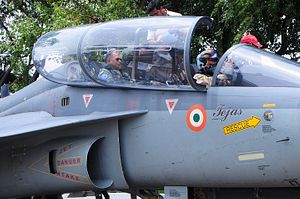T. Suvarna Raju, the chairman and managing director of India’s state-owned aircraft maker Hindustan Aeronautics Limited (HAL) reiterated in a statement his belief that the Tejas Light Combat Aircraft (LCA) will form the “backbone of IAF combat power in the years to come”, following a test flight of a two-seat variant of the aircraft in Bengaluru on August 8.
“It is a wonderful flying machine,” Raju added, according to a HAL press statement. “In a thrilling set of maneuvers, the aircraft climbed to 30,000 feet and accelerated to supersonic speed of 1.1 Mach. This was followed by a simulated launch of Beyond Visual Range [BVR] missile on a target of opportunity,” Raju said after the sortie.
A Tejas Mark-I last test fired a I-Derby BVR air-to-air missile at a test range off the coast of Goa in April. The I-Derby BVR missile has been test fired prior to April. It constitutes the Tejas LCA’s main air-to-air weapon system and is launched from missile rail launchers fitted underneath the aircraft’s wings.
During the demonstration flight, a number of other capabilities of the aircraft were tested. “An attack on the ground target was carried out by a simulated laser guided bomb,” according to the HAL press release. “The landing was carried out simulating low visibility conditions using the ‘automatic approach’ mode of the aircraft.”
The Tejas LCA is a supersonic, single-seat, single-engine multirole light fighter aircraft that has been under development by the Aeronautical Development Agency in cooperation with HAL since the early 1980s. However, as of August 2018, the Tejas has still not achieved final operational clearance by the Indian Aeronautical Development Agency.
As I noted last month:
The [Ministry of Defense] MoD first announced in 2011 that the Tejas LCA would be combat-ready by 2012. However, six years later the IAF flies 20 (as of December 2017) Tejas LCA in initial operational configuration (the service’s minimum operational requirements).
The Indian Air Force placed an initial order for 40 Tejas LCA Mark-I with HAL. Moreover, in December 2017, the IAF issued a tender for the procurement of 83 additional Tejas LCA including 73 single-engine Tejas LCA Mark-IA and 10 tandem two-seat LCA trainer aircraft.
I explained previously:
The IAF has listed several technical deficiencies found on the Tejas LCA Mark-I variant in 2017. These flaws will purportedly will be addressed in later variants of the aircraft, which will include 43 improvements over the existing version.
Upgrades will include an advanced active electronically scanned array (AESA) radar system, a new electronic warfare sensor suite, and a new externally refueling capability.
HAL is in the process of increasing production capacity from eight to 16 aircraft per year, although as of this July, the Indian aircraft maker has so far failed to meet the target of even producing eight Tejas LCA per year.
Nonetheless, the HAL statement reads: “In order to ensure the speedy deliveries of LCAs, HAL has ramped up the production rate to meet the requirement of IAF in association with other industrial partners.”
The naval version of the Tejas LCA has successfully completed the first test of the fighter jet’s arrestor hook or tail hook system earlier this month.































